Idea crowdsourcing tools help organizations use the collective intelligence of their entire workforce (and outside users like customers and partners) to find ways to address certain innovation priorities.
In our experience doing innovation consulting for corporations over the last decade, there are three factors organizations should consider when looking for an idea crowdsourcing tool:
Does the tool allow you to collect ideas related to your priorities? Unless users are explicitly educated on the organization’s priorities, it’s unlikely that they’ll submit ideas to address those priorities. So, an effective crowdsourcing tool should enable you to educate users on what the organization is currently focused on and only allow them to submit relevant ideas.
Does the tool have features to crowdsource idea feedback? Almost all ideas have flaws that need to be ironed out before implementation. An effective crowdsourcing tool should facilitate idea improvement by allowing everyone inside the company to see each other’s ideas and make suggestions.
Does the tool support ideas through their entire lifecycle? Organizations that consistently turn ideas into beneficial products, services, and processes don’t stop after idea collection. They have defined innovation processes and tools to assess, validate, and launch ideas. The final factor to consider is whether the idea crowdsourcing tool has features to not only collect ideas but also drive them toward implementation.
To help innovation managers choose the right idea crowdsourcing tool, we review five options on the market, starting with our platform, InnovationCast, and how we designed its idea collection features to fulfill the criteria above.
We then cover Qmarkets, Brightidea, Ideanote, and HYPE Innovation, enabling you to evaluate their features on your own.
To learn more about how InnovationCast can help you crowdsource high-quality ideas, schedule a free demo.
Are You Looking to Simply Crowdsource Ideas or Develop Them Into Shippable Solutions?
Before discussing the top crowdsourcing tools, it’s important to note that the best choice depends on why you need a crowdsourcing tool in the first place.
If you’re an innovation manager looking to crowdsource ideas from employees, customers, and other users, and turn them into impactful solutions, you need a tool that supports not only idea collection but also assessment, validation, and implementation.
Many organizations believe that crowdsourcing ideas is the innovation process itself. While they may gather promising ideas, without the right systems and tools to develop them solutions, the ideas often remain untouched.
The most successful innovation programs view crowdsourcing as just the first step of a larger innovation process. These organizations use predefined criteria to assess ideas, workflows to test them, and systems to nurture the best ones through to implementation.
In this guide, we focus on tools that not only excel at idea crowdsourcing but also support ideas through their full lifecycle: assessment, validation, implementation, and impact tracking.
However, if you only need a basic crowdsourcing tool without validation and implementation features, you can skip to the end of the article where we review simpler options.
1. InnovationCast
Innovation Management Software with Targeted Idea Collection Features
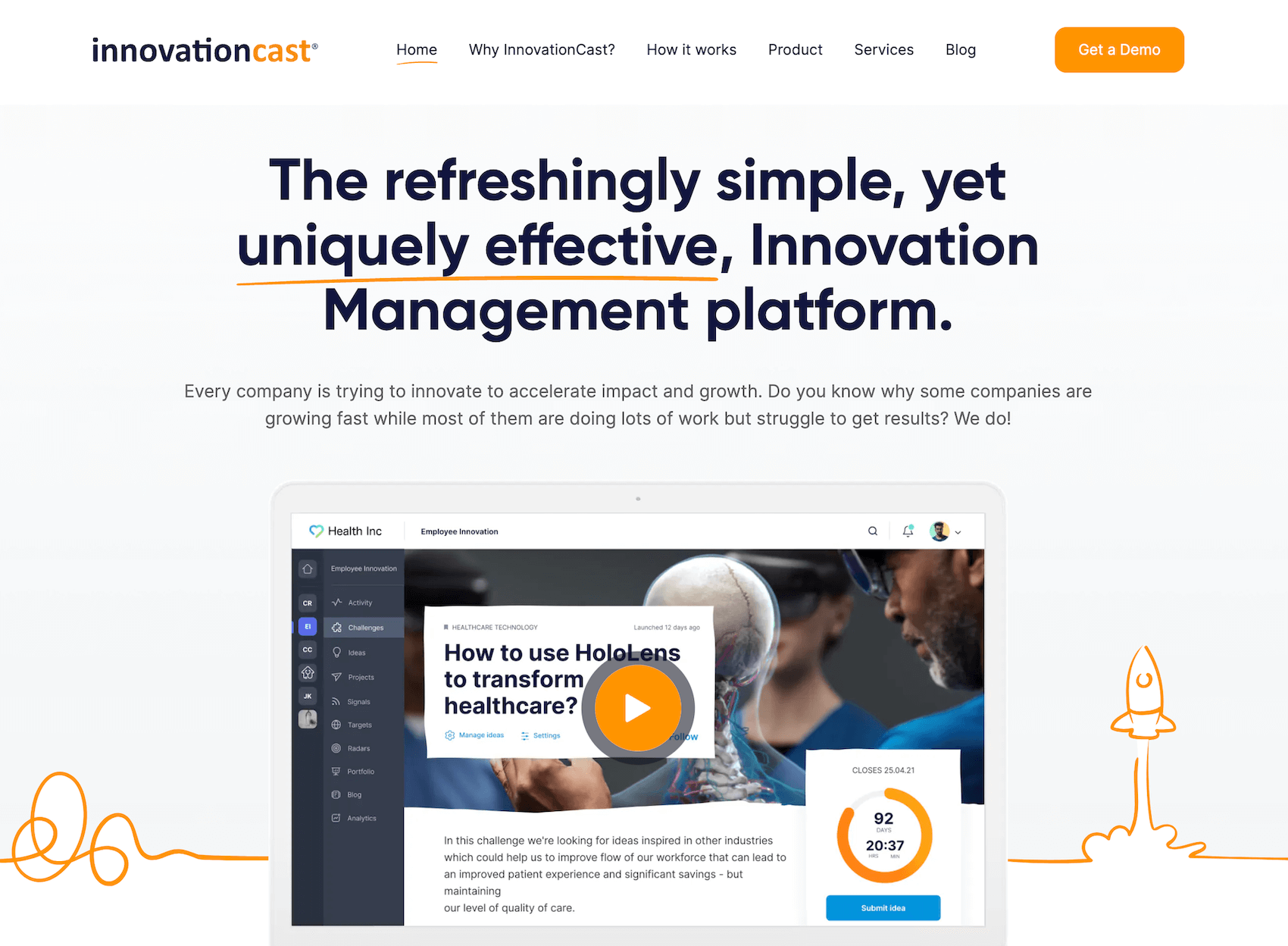
InnovationCast is an innovation management platform with intentionally designed idea crowdsourcing features.
You can collect ideas aligned with your priorities by creating Innovation Challenges and attaching resources for users to review before submitting ideas. This gives users a clear understanding of the organization’s current focus and helps them better grasp the priorities.
Additionally, ideas can be displayed on the InnovationCast activity feed, allowing other users to view their colleagues’ ideas and suggest improvements. This approach leverages crowdsourcing for collaboration and the refinement of ideas.
Let’s explore these features further.
Innovation Challenges: Crowdsource Ideas Specific to Your Priorities
To help innovation managers collect ideas related to their priorities — not just any and all ideas that users may have, we added Innovation Challenges to InnovationCast.
Innovation Challenges are time-bound invitations for users to share ideas on certain organizational priorities. Innovation managers and stakeholders can create challenges around initiatives they’ve been tasked with, whether that's launching a new product or improving an operational process.
They can then add descriptions of the priority to the challenge as well as additional resources such as customer interviews, market research data, FAQs, or anything that can help users understand the priority in more detail.
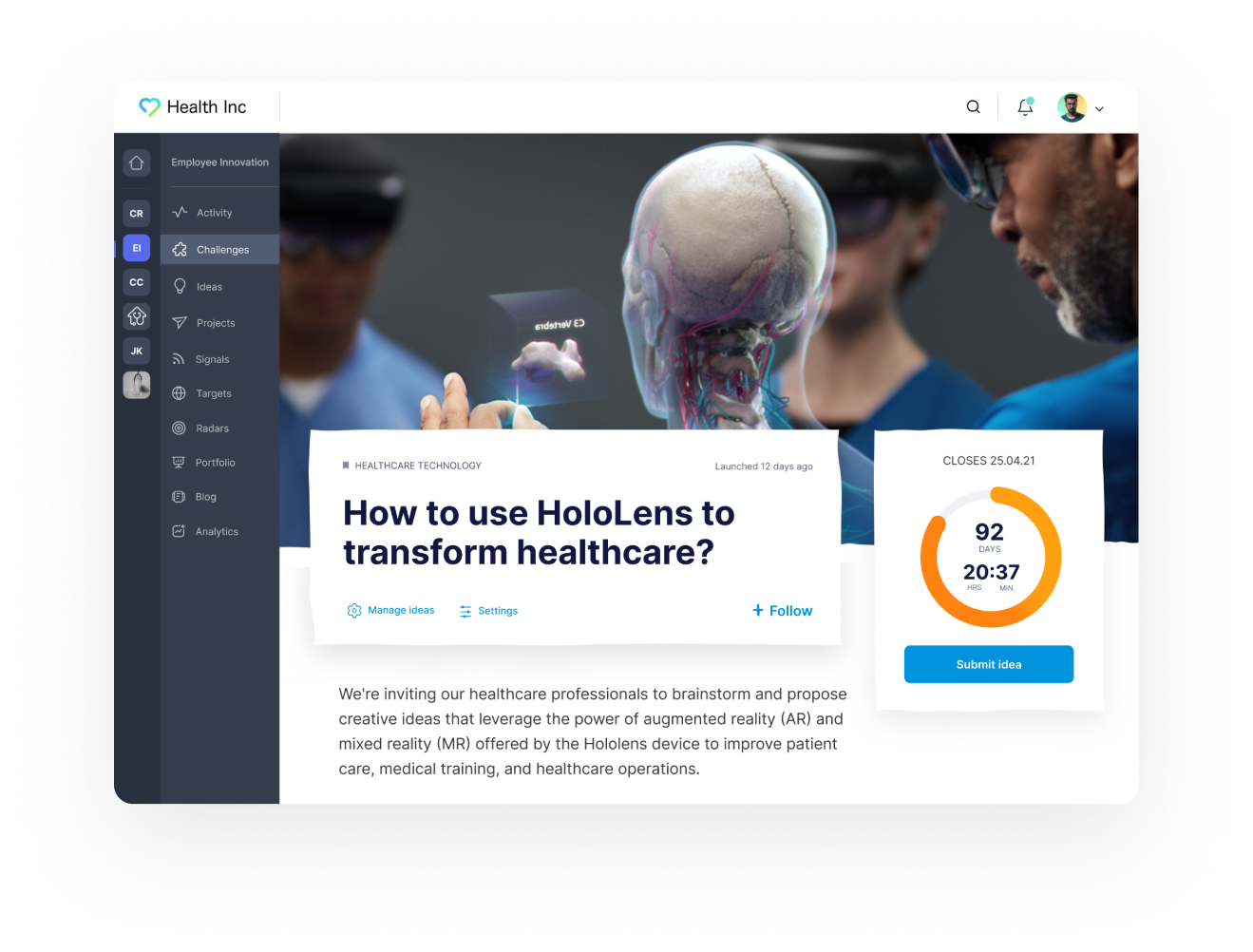
In addition, challenge managers can create custom submission forms asking idea authors to discuss the value of their idea, who it can benefit, and the resources required for implementation. This, alongside the resources attached to the challenge, helps source higher-quality ideas compared to a context-less, open call for any and all ideas.

Finally, with a finite timeframe for responding to each challenge, users are encouraged to actively participate. This helps innovation managers quickly collect ideas on urgent priorities.
Read more: 5 Detailed Innovation Challenge Examples & Best Practices
Category-Based “Always On” for Users to Submit Ideas 24/7
Although we strongly recommend using challenges, open calls for ideas can still be effective for innovation managers seeking a more passive idea stream.
The key is to ensure that open calls still direct users to organize their ideas into specific topics relevant to the organization. Without this guidance, users may submit unrelated ideas. This is why InnovationCast includes an “Always On” idea collection feature.
Innovation managers can set up predefined categories for ideas. When a user submits an idea, InnovationCast prompts them to categorize it into one of these predefined topics, ensuring alignment with broader organizational priorities.
For example, the screenshot below shows an innovation department requiring users to categorize their ideas into one of four areas: new healthcare technology, patient experience, infection control, and sustainable healthcare. This approach communicates to employees the specific areas where ideas are currently sought.
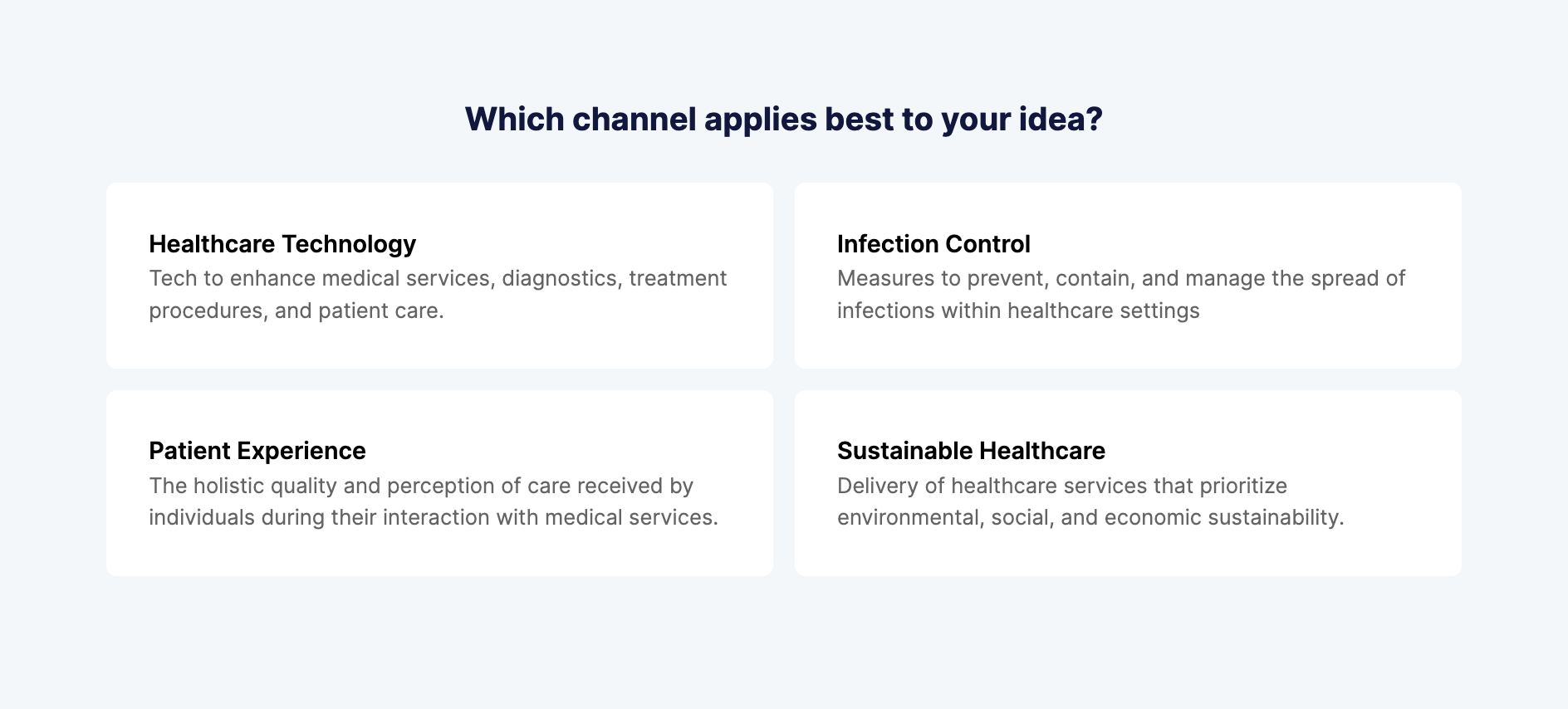
Crowdsourced Idea Improvement
Most ideas aren’t ready to launch directly after submission, as they typically have weaknesses that need to be improved. With this in mind, we added a feature to InnovationCast that allows challenge managers to crowdsource idea improvement.
When a user submits an idea, it’s displayed on the InnovationCast news feed for their colleagues (and potentially external subject matter experts) to see.

These users can review the details of each idea and vote on what they think about it, whether it “Looks good,” “Not so good,” or if they’re “Undecided.”
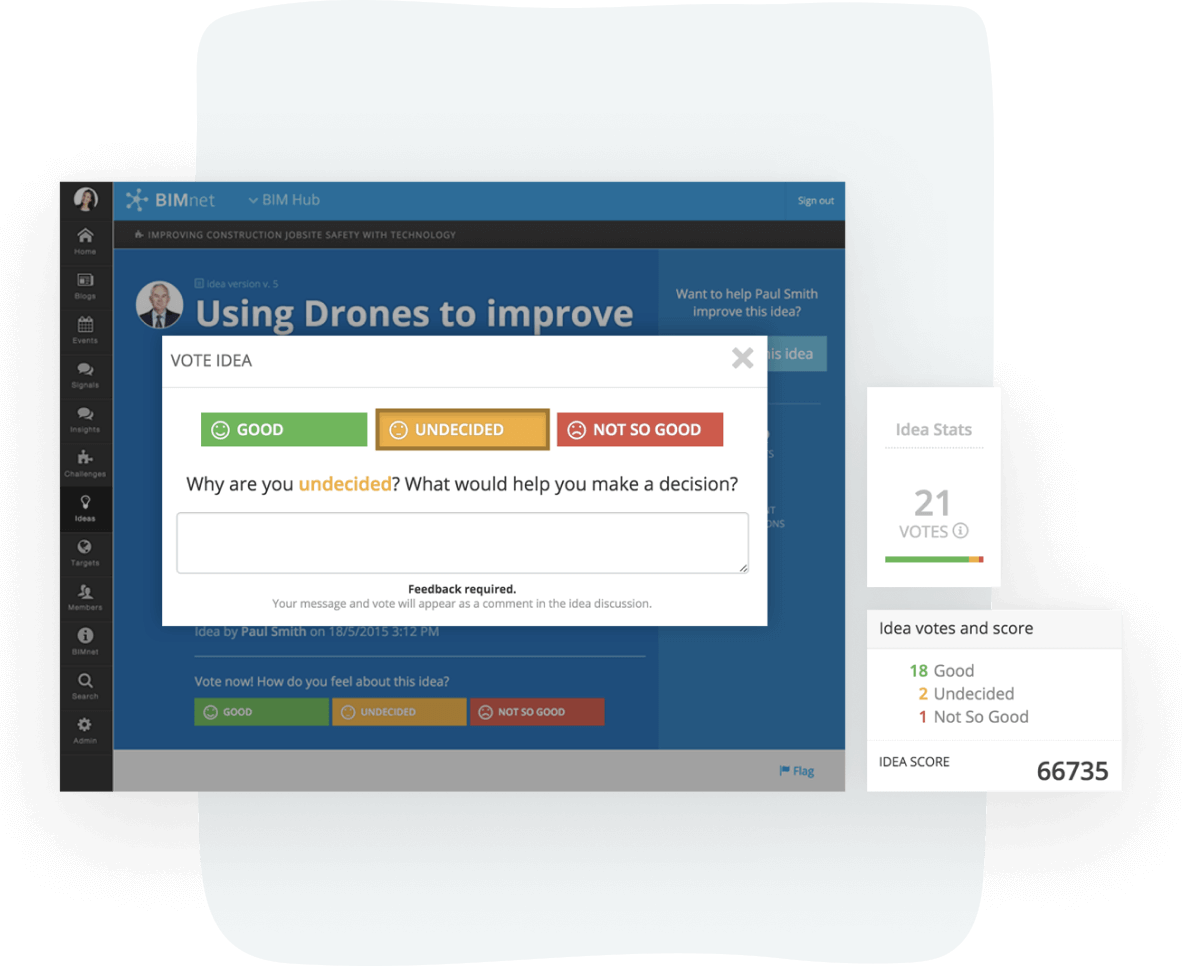
To ensure users provide valuable feedback for refining ideas, InnovationCast prompts them to explain their vote, suggest improvements, and collaborate with the original authors for refinement.
This step allows innovation managers to utilize the expertise of various teams within the company (finance team, marketing team, engineering team, etc.) to improve ideas.
Moreover, because users can track the progress of their ideas — whether they move forward to assessment, validation, or implementation — engagement with future innovation efforts is increased.
Read more: How to Create a Collaborative Innovation Process and Network
Signals & Scouting to Crowdsource News Insights
Crowdsourcing can also help innovation managers monitor trends by leveraging the collective brain power of the entire organization. This allows them to stay updated on competitor products, emerging startups, new technologies, and industry trends.
To facilitate this, we designed InnovationCast with a feature called Signals & Scouting. This centralized hub allows users to share the latest news and developments they believe others in the company should be aware of.
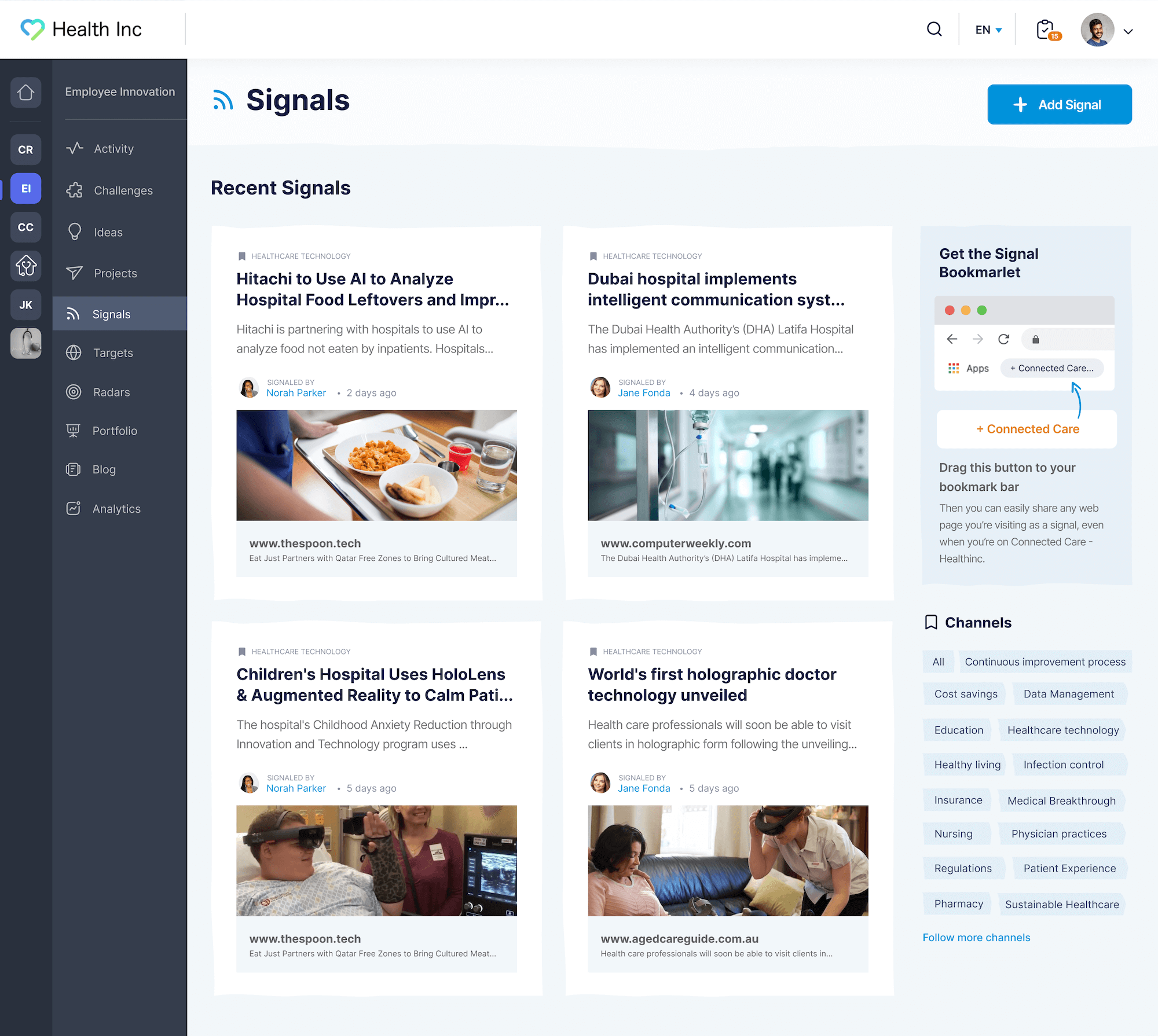
When users log into InnovationCast, they can view and discuss these resources. Stakeholders can then assess the impact of this news on the organization and fuel the creation of new ideas.
For example, if an employee at a smart home technology company sees a social media post about a competitor's new voice control feature, they might question if their company should develop something similar. They can share this post via Signals, allowing colleagues, managers, and stakeholders to discuss and decide on the appropriate actions.
While news sharing often occurs through messaging apps, email threads, and video calls, consolidating all these resources in a single hub amplifies collective input and sparks discussions about new ideas.
Tools to Boost Idea Submissions
Having effective idea-collection features is only one part of the solution — you also need motivated employees to submit ideas.
A common challenge organizations face with crowdsourcing ideas is engaging employees, as it requires them to step away from their daily tasks to contribute ideas.
To address this, we designed InnovationCast with features specifically aimed at encouraging participation:
Employee Badges & Rewards
Onboarding training materials & email reminders
Employee Badges & Rewards
To maintain employee engagement, InnovationCast includes a badges and rewards system.
Employees earn points for completing specific tasks — such as submitting ideas chosen for validation or providing valuable feedback — which can be redeemed for cash prizes, gift cards, PTO, or other rewards of your choice.
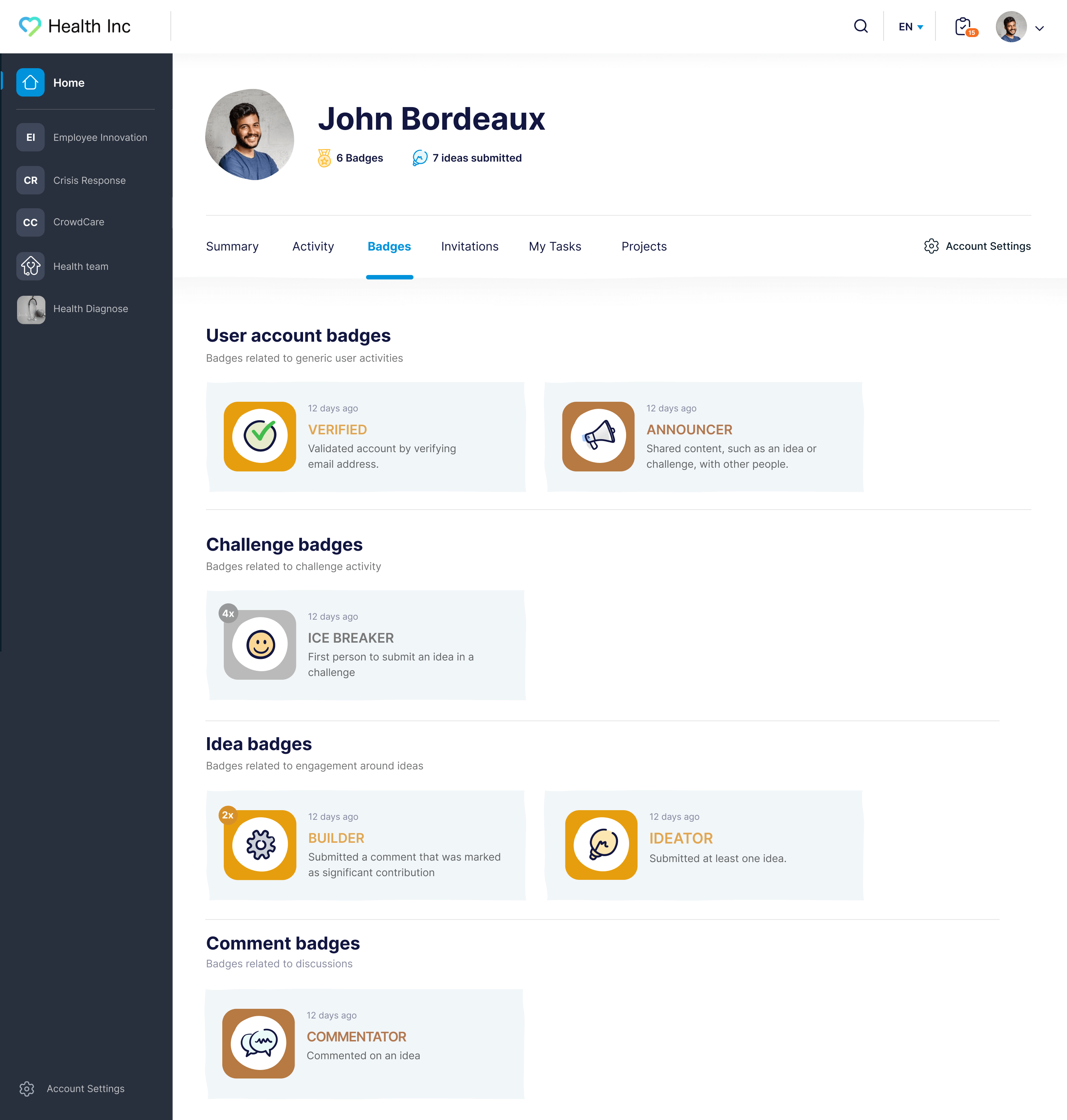
This system motivates employees to submit ideas and accumulate points, which they can then use for their preferred rewards.
Read more: How to Encourage Innovation in the Workplace
Onboarding Training Materials & Email Reminders
InnovationCast includes training materials to onboard employees effectively.
These resources offer tutorials on navigating the InnovationCast interface, responding to challenges, posting Signals, and providing constructive feedback. This eliminates the need for innovation managers to create training materials or manage the onboarding process.
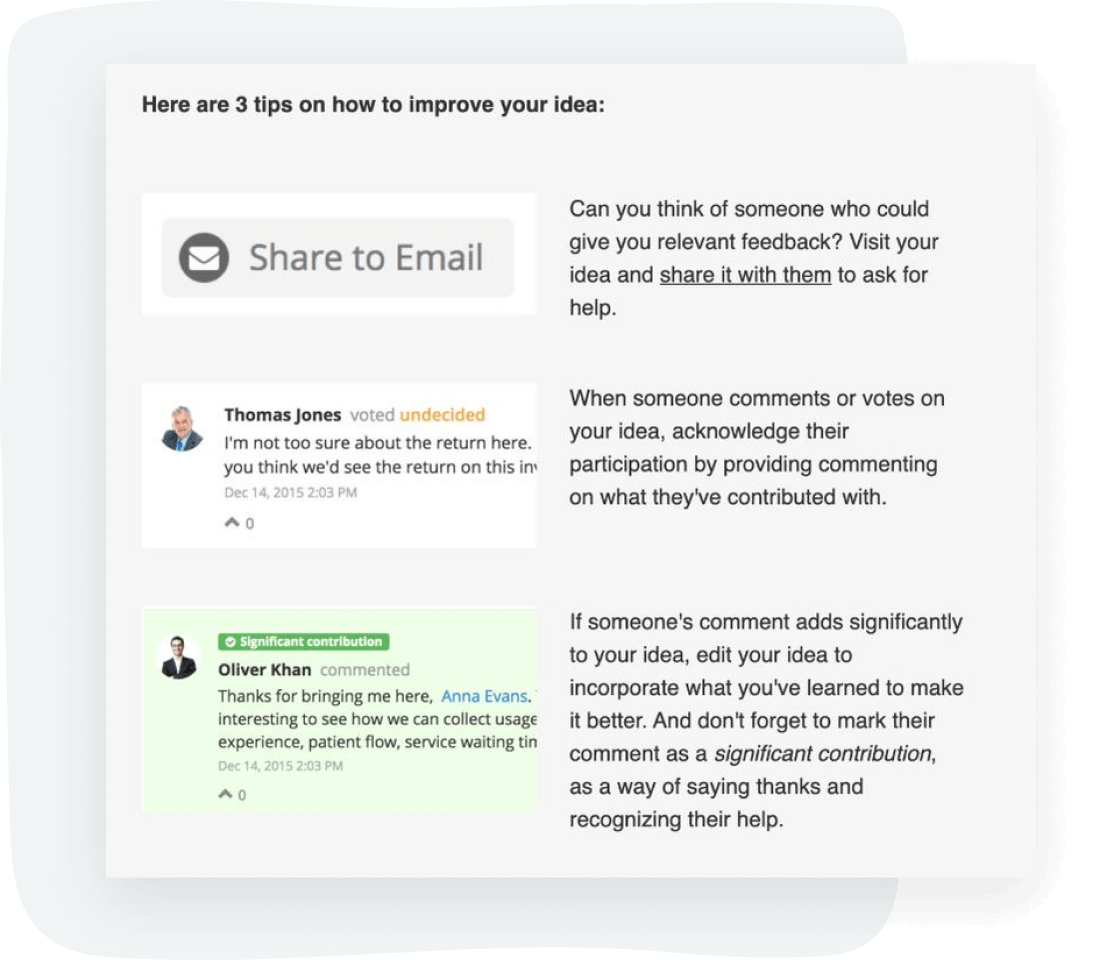
Additionally, we provide email templates that can be set to automatically notify users of new challenges and send periodic reminders to submit ideas, keeping the organization’s priorities fresh in their minds.
Tools to Validate and Implement Ideas
As we alluded to earlier, idea crowdsourcing is simply one aspect of establishing an innovation process that reliably produces products, services, and processes that benefit the organization.
Once ideas are collected, there must be systems in place to evaluate their feasibility and potential value, run experiments to determine whether they live up to expectations, and track their impact.
To do this, many organizations will use several different tools to piece together the innovation process. They'll use a crowdsourcing tool to gather ideas, market research tools to validate them, project management tools to implement them, and analytics tools to measure their success.
However, in our experience, this often results in an innovation management process where ideas are constantly siloed or lost. There isn't a centralized platform where users can view all ideas and know whether they’re on track to launch or behind schedule.
Understanding this, we designed InnovationCast with features that allow you to manage an idea's entire lifecycle, from collection to implementation and impact tracking. This includes:
Idea evaluation workflows: These workflows outline the tasks teams must complete to validate an idea's impact, feasibility, and risk. Depending on the idea, these tasks may include building a business case, testing a prototype, or interviewing customers. This ensures that everyone understands their tasks and responsibilities in validation.
Portfolio management: After department leaders validate and select the most promising ideas for launch, they can review all past and current projects in our portfolio management dashboard. This feature allows them to analyze project outcomes, investigate validation and implementation steps, and use these insights to refine future innovation processes.
Read more: 6 Best Innovation Portfolio Management Software in 2024
Crowdsource High-Quality Ideas with InnovationCast
Our innovation management platform has assisted companies like DHL, Novo Nordisk, and ING in not just collecting ideas but also establishing processes to implement them. In fact, we increased idea submissions for DHL by 67% and boosted idea implementation by 14% within just four weeks.
To see how we can do something similar for your organization, book a demo here.
2. Qmarkets
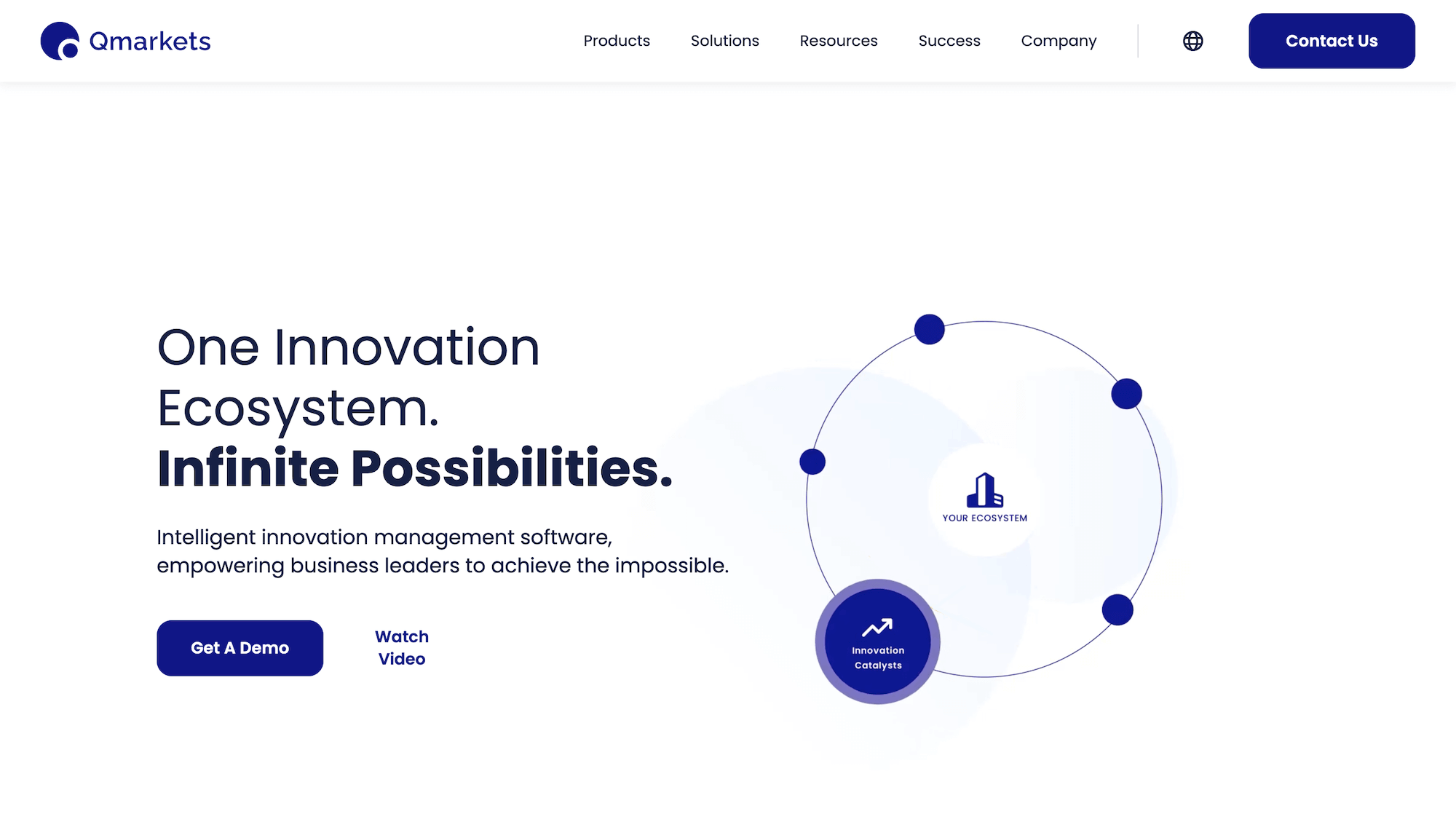
Qmarkets is enterprise innovation management software that allows innovation managers to source ideas from employees and outside users. Its features include challenges, where users can respond to the organization’s priorities with ideas, and a digital brainstorming hub that lets users work together to develop innovative solutions.
During onboarding, Qmarkets’ customer success team shows you how their platform works. They walk you through collecting ideas, evaluating them to find the best ones, implementing them, and finally, tracking their impact.
Features
Q-ideate — This is Qmarkets’ idea crowdsourcing feature. Innovation managers can create postings describing the areas of the business they want to focus on and then send emails to users, prompting them to get involved.
Q-optimize — This is Qmarkets’ continuous improvement system. Users can suggest ways the company can improve its products, services, and processes. Innovation managers and stakeholders can then assess these ideas and potentially implement them.
Q-trend — This functionality allows innovation managers and stakeholders to stay updated on the latest industry trends. They can scan micro, macro, and megatrends related to their industry, prioritize their importance, and, if necessary, develop and implement new solutions.
Q-scout — Innovation managers can create a challenge and request outside users such as students, startups, online communities, and researchers to respond with possible solutions.
Q-impact — Innovation managers can view all previous and current projects and track their impact on the company.
AI features — Innovation managers can use AI to generate ideas and source insights related to their industry.
Pricing
Qmarkets doesn’t display the cost of its innovation product publicly. You need to book a call with its customer success team, and they’ll give you a demo based on the number of users you need to support and the features you want to access.
3. Brightidea
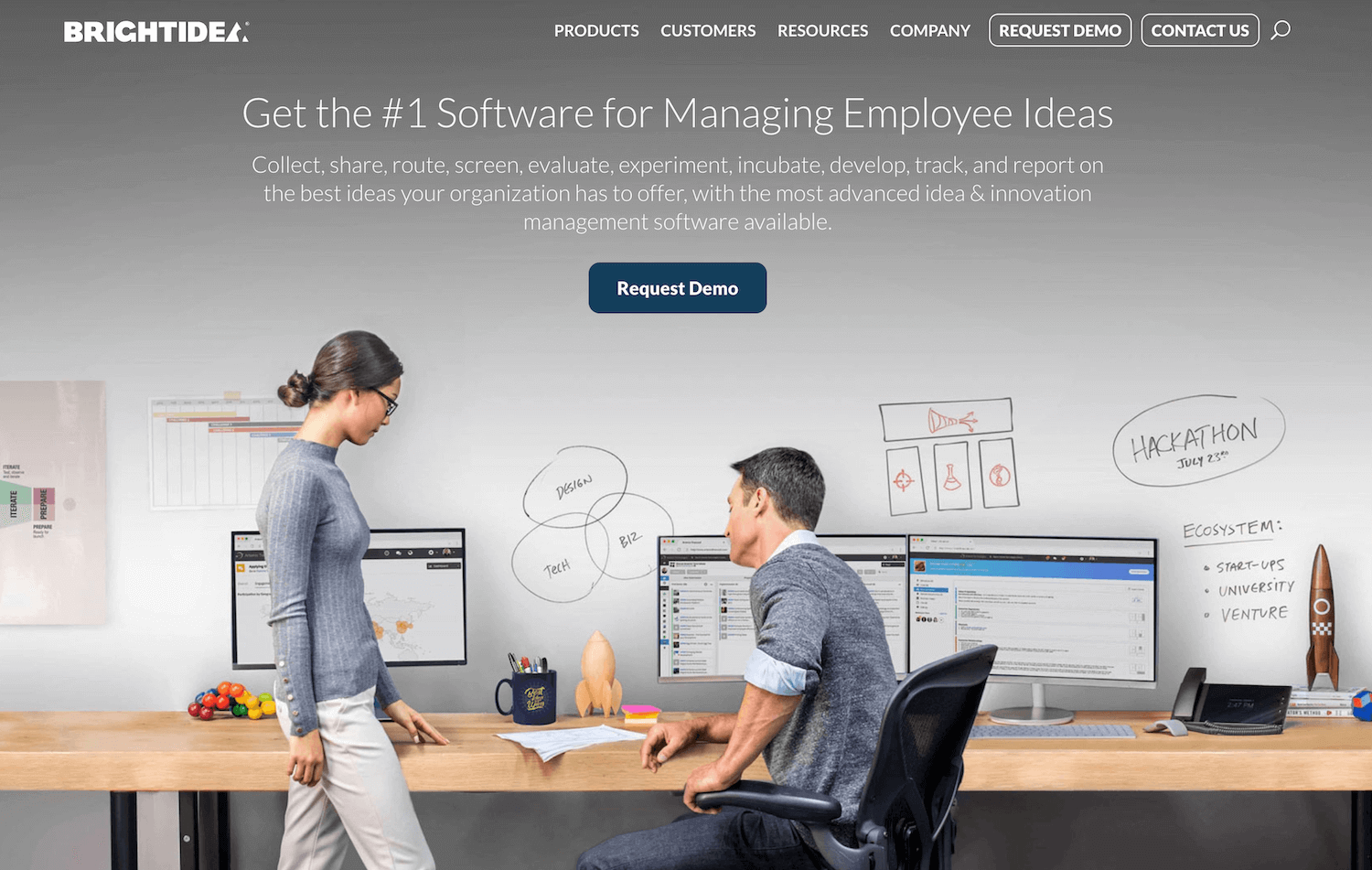
Brightidea is an idea and innovation management software designed to help innovation departments identify business challenges and crowdsource ideas to solve them.
Their team helps you narrow down the core aspects of the business you want to address, then sets up idea boxes and other idea collection features to help you crowdsource ideas. They also show you how to use their platform to validate ideas and measure their impact.
Features
Idea box — Innovation managers and other stakeholders can inform participants about a certain pain point or objective and ask them to submit ideas.
Program — Innovation managers can create challenge postings around urgent priorities they need ideas on, set a deadline for when the challenge closes, and invite a group of people to brainstorm and submit ideas.
Hackathon — Innovation managers can invite programmers and other technical professionals inside and outside the company to build products that can help achieve goals or solve specific problems.
Lab — Innovation managers can assign validation tasks to teams inside and outside the organization. Then, they can view all the projects teams are currently working on as well as live projects.
Ecosystem — This open innovation platform allows innovation managers to access outside subject matter expertise to find ideas, products, and services that can help address priorities.
Transformation — Innovation managers can run transformation projects to promote company-wide change.
Pricing
Many users say that Brightidea’s pricing plans start at $59 per month. If you’d like to receive a more detailed quote, you need to book a demo with their team.
4. Ideanote
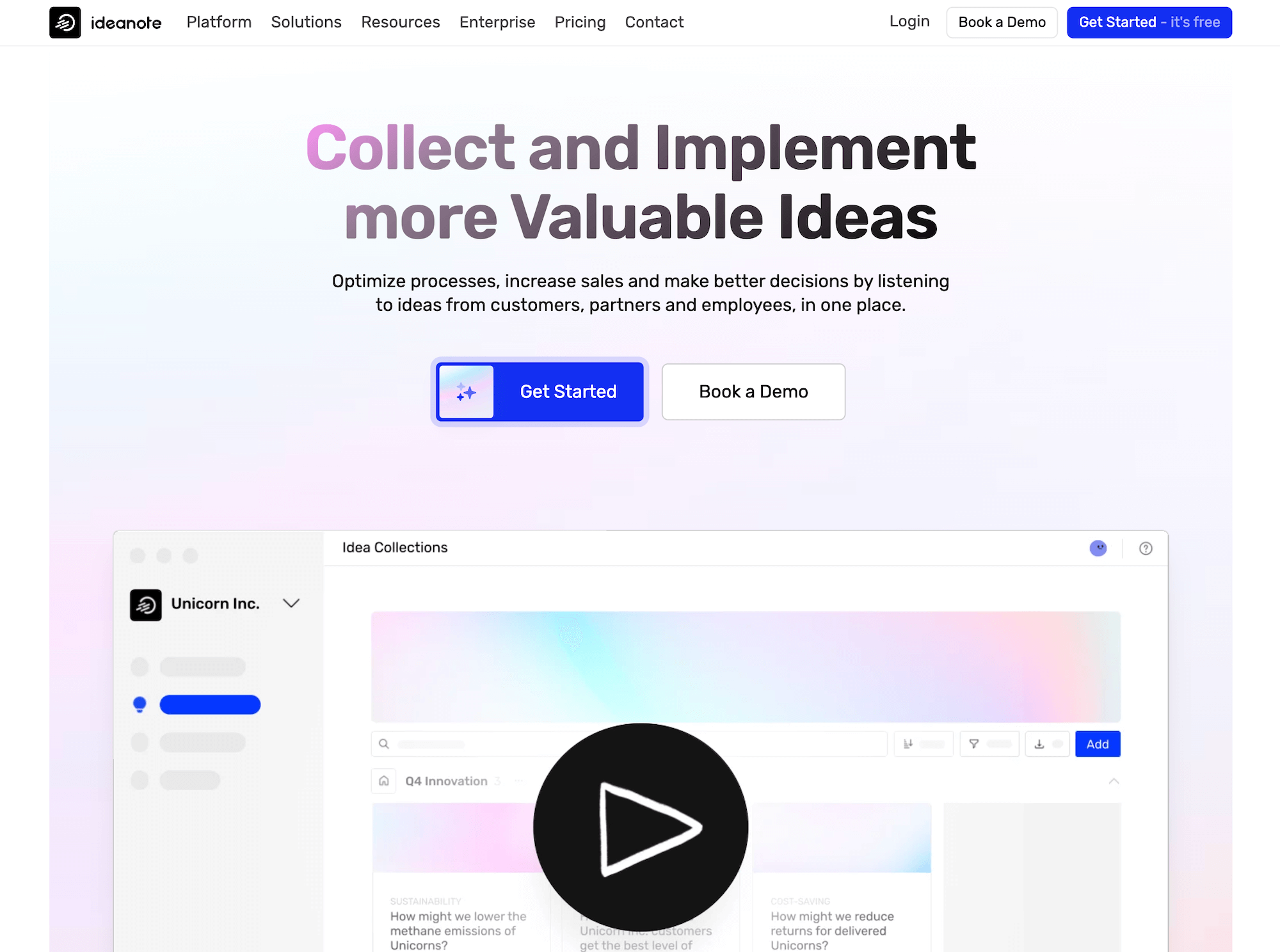
Ideanote is idea management software that markets itself to enterprise companies with remote teams who need to centralize innovation efforts. It works in over 12 languages, and the AI can accurately translate messages, allowing teams to collaborate regardless of their language.
Features
Collect — Innovation managers can invite participants to Ideanote and prompt them to share ideas about the company’s priorities. These ideas can be organized on the Ideanote dashboard for selected users to assess.
Engage — Innovation managers can use Ideanote’s training materials to show participants how the platform works. They can use rewards to incentivize participants to submit ideas.
Manage — Innovation managers and other key decision makers can view submitted ideas and decide on which ones to pursue and which to table.
Measure — Innovation managers can organize all live projects inside the Ideanote dashboard, track their progress, see their impact on the company, and use this knowledge to launch ideas more efficiently in the future.
AI — Innovation managers can describe their priorities, and Ideanote AI will propose solutions. Additionally, innovation managers can have AI assess ideas and give input on which ideas the organization should prioritize.
Automate — Innovation managers can set up automated workflows that execute tasks based on certain triggers. For example, if the product team is finished with the MVP, Ideanote may automatically notify customer support to begin interviewing customers.
Pricing
Ideanote has three pricing plans:
The Free plan allows you to host up to 10 users.
The Business plan allows you to host up to 1000 users, and costs $49–$859 per month.
The Enterprise plan allows you to host unlimited users and costs $2,899 per month.
5. HYPE Innovation
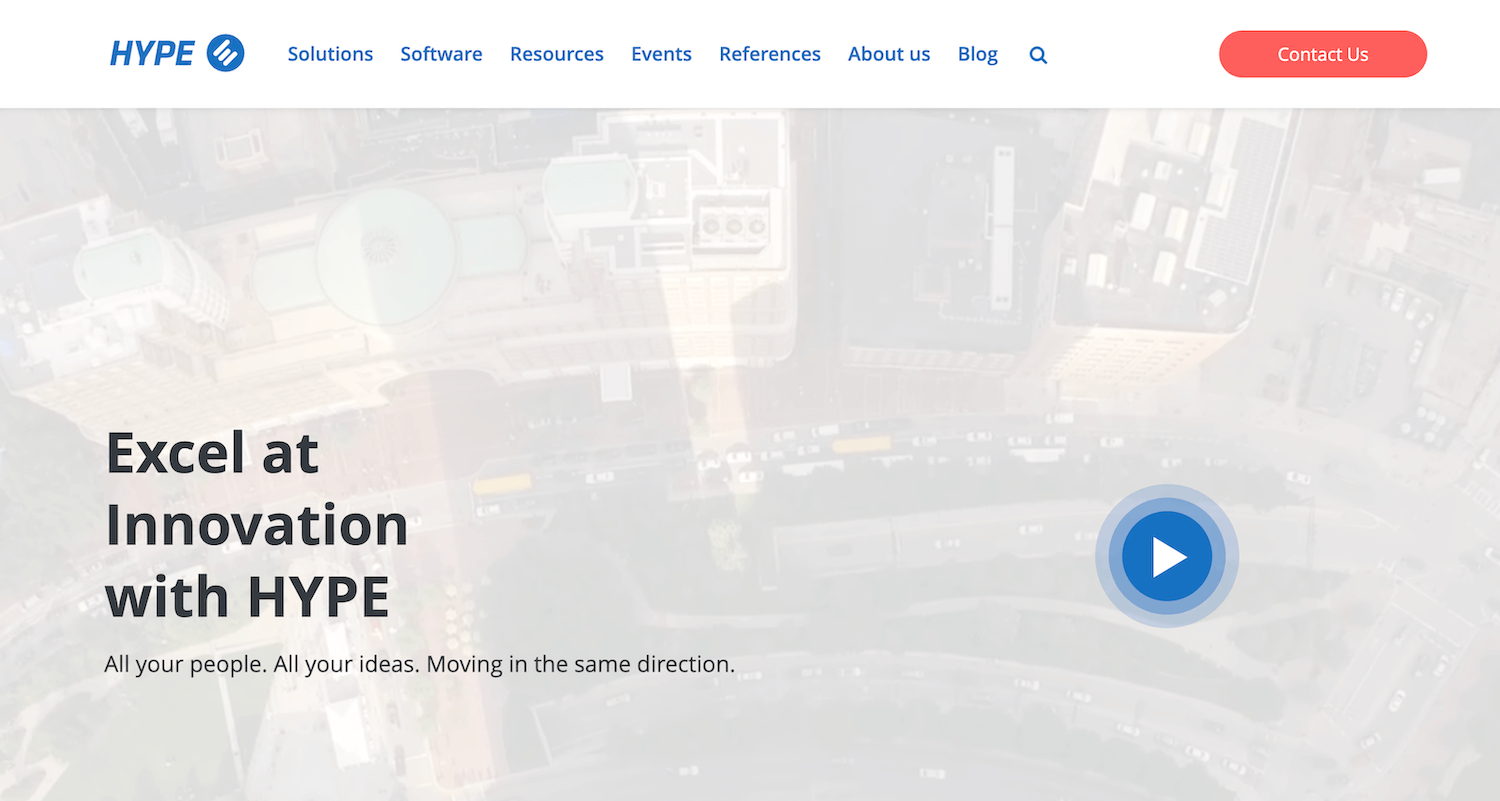
HYPE Innovation is an innovation management software and consulting firm tailored to enterprise companies. During onboarding, their consultants will join you on a call to show you how to create an innovation strategy and set up challenge postings that can source ideas on these topics.
Features
Idea generation + brainstorming — Innovation managers can encourage employees and outside users to collaborate and submit ideas that benefit the company.
Technology scouting — Innovation managers can stay updated on the latest industry news, competitors, and potential threats using HYPE’s database of over 10,000 technologies.
Trend management — Innovation managers can spot strategic opportunities by monitoring emerging trends within their industry.
Employee engagement — Innovation managers can use flares and incentives to drive innovation and engage users.
Hackathon templates — Innovation managers can encourage problem-solving by asking programmers to work together and develop certain software products.
Pricing
HYPE Innovation doesn’t display the price of its plans on its websites. You need to book a call with the customer success team for a custom quote.
7 Alternative Idea Crowdsourcing Tools: Runner-Ups
The tools we covered above support all of the steps that proceed idea collection — assessing, testing, launching, and tracking. However, if you’re only looking for a crowdsourcing tool and don’t need validation and implementation features, you may consider these options:
Miro is a digital whiteboard tool that allows you to invite users to the platform where they can brainstorm business ideas and map out the processes required for implementation.
Coda is a text editing tool designed for team collaboration. It allows you to create a document specifying the ideas you need and request contributions from team members.
Canny is a collaborative feedback tool that allows product teams to collect and organize customer feedback so they understand what improvements customers want them to make to their products.
Bluescape is a brainstorming tool that lets organizations share information about their priorities and ask employees and other users to generate ideas.
UserVoice is an idea crowdsourcing platform that helps product teams improve their products by collecting customer feedback in real-time and organizing it inside a hub, where they can understand which issues they need to address first.
Microsoft Teams wasn’t designed for crowdsourcing specifically, but team leaders can use it to create channels for collaboration and problem-solving.
uTest is a crowdsourcing platform for software testing that connects you with skilled testers to evaluate your product and provide improvement suggestions before market release.
Establish a Culture of Innovation with InnovationCast
To learn more about how you can use InnovationCast to crowdsource ideas from employees and develop them into shippable solutions, book a demo with our customer success team.
Related reads:

